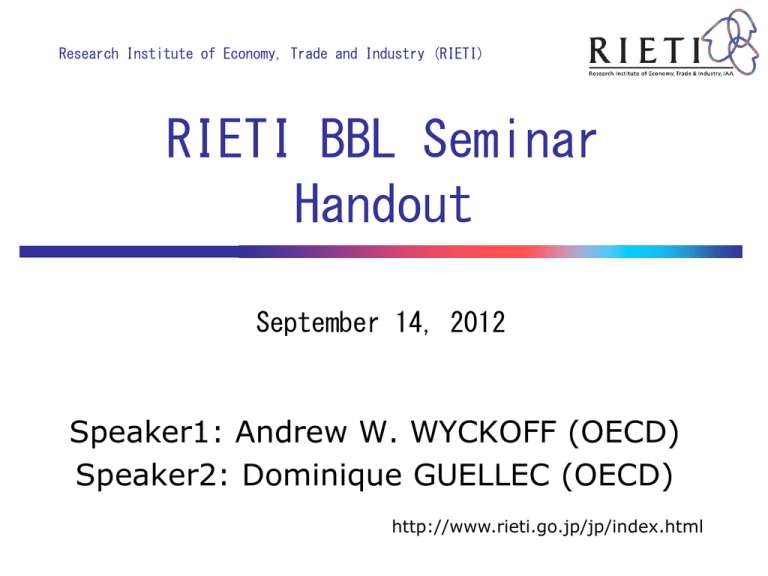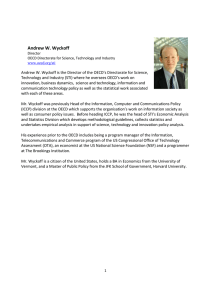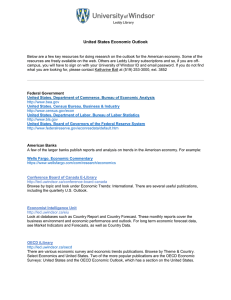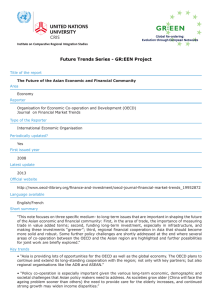RIETI BBL Seminar Handout Speaker1: Andrew W. WYCKOFF (OECD)
advertisement

Research Institute of Economy, Trade and Industry (RIETI) RIETI BBL Seminar Handout September 14, 2012 Speaker1: Andrew W. WYCKOFF (OECD) Speaker2: Dominique GUELLEC (OECD) http://www.rieti.go.jp/jp/index.html INNOVATION IN THE ECONOMIC CRISIS AND BEYOND Dominique Guellec Caroline Paunov Country Studies and Outlook Division Directorate for Science, Technology and Industry OECD Structure of the presentation 1. Innovation and the macro economy 2. Innovation in the current crisis 3. Policies 4. The Outlook for innovation? 2 3 key factors of the current business cycle for innovation Downturn in Economic Activity Weaknesses in Financial Systems High Levels of Sovereign Debt What to expect for innovation? Two factors for aggregate innovation: i) innovation performance of the existing system and ii) firm dynamics/ entrepreneurship Reduced demand for products → competition (“creative destruction”) → resource reallocations Public budgetary situation Reduced demand for products → cash flows reduce innovation possibilities → demand for high-tech products → competition (“rents” for innovation) Reduced liquidities Uncertainties Public budgetary situation Innovation in the crisis and beyond 1. The economic crisis that started in 2008 has negatively affected business innovation and R&D in all countries. 2. The crisis and the recovery have been uneven across countries, industries and categories of firms. 3. Some have featured better: countries in Asia, including Korea and China; large multinational firms in high tech industries. 4. VC, start ups and SMEs have been hit the hardest, and have not recovered yet (entrepreneurship still low). 5. The crisis has revealed and amplified weaknesses (and strengths) which pre-existed, across countries, sectors and firms. 5 Business enterprise R&D has partially recovered after the 2008-9 shock BERD funded by business, yearly growth rate (%) 10.0 5.0 0.0 Japan United States Total OECD -5.0 EU-15 -10.0 -15.0 2001 2002 2003 2004 2005 2006 2007 2008 2009 2010 6 Source: OECD. A deep through followed by a fragile recovery Patent Filings are hit by the crisis PCT Filings; 5 months moving average; yearly growth rates (%) 15 US 10 EU World 5 0 -5 -10 -15 2007 Source: WIPO. 2008 2009 2010 2011 2012 7 Large firms have recovered quickly Growth rates in R&D investments and sales of top EU and US corporate R&D investors, 2008-10 (%) 8 Source: EU (2011), R&D Scoreboard. Large medium-tech manufacturers (e.g. automobile) have been hit strongly Sales, R&D and employment growth for firms in high-, medium-high and low-technology industries, 2008-09 and 2009-10 (%) 2008-09 Companies in high-tech industries (N. 475) % Sales Sales R&D 2009-10 Companiesininmedium-tech medium-techindustries industries Companies (N.359) 359) (N. Employment Sales Sales R&D Employment Employment Companiesininlow-tech low-techindustries industries Companies (N.103) 103) (N. Sales Sales Employment R&D 15 9.4 9.9 10 4.5 5 3.9 5.5 4.4 5.6 4.3 3.0 1.5 0.6 3.8 0 -5 -2.9 -3.8 -1.4 -0.6 -6.5 -10 -15 -16.3 -20 9 Source: OECD STI Outlook 2012 based on EU (2011), R&D Scoreboard. Business dynamics: More destruction than creation Creation of new businesses Australia Denmark Finland United States Bankruptcies Australia Germany Germany 150 150 140 140 130 130 120 120 110 110 100 100 90 80 70 60 Japan Netherlands Finland 90 80 70 60 50 50 10 Source: OECD STI Outlook 2012 based on OECD (2012), Entrepreneurship at a Glance. Venture Capital Investment has partially recovered in the US Sum of deal value, quarterly amount, billion USD 9 8 7 6 5 4 3 2005 2006 2007 2008 2009 2010 2011 2012 11 Source: Extracted from the OECD STI Outlook 2012 based on Venture One, Money Tree. Certain countries have better resisted to the crisis than others: China, Korea Business funded R&D, yearly growth rate (%) 35.0 30.0 25.0 20.0 15.0 Korea Total OECD 10.0 China 5.0 0.0 -5.0 -10.0 2001 2002 2003 2004 2005 2006 2007 2008 2009 Source: OECD, Main Science and Technology Indicators (MSTI) Database, June 2012. 2010 12 An further step in the rise of the innovative strength of China and Korea United States Netherlands Germany United Kingdom Japan France Korea China Other Countries 100% 90% 20.2 19.9 20.6 19.9 19.6 19.4 19.3 19.6 20.3 19.6 19.1 18.0 80% 0.8 1.7 4.4 1.6 2.1 4.3 0.9 2.3 4.6 1.1 2.6 4.5 1.4 2.9 4.2 1.8 3.4 4.2 2.6 4.0 4.2 12.7 15.1 5.1 5.2 4.7 9.0 11.0 3.7 4.8 4.3 7.5 10.3 3.4 4.4 4.1 16.5 18.2 5.9 4.4 5.7 4.1 18.1 17.3 17.6 19.6 21.4 3.0 2.7 10.7 10.3 2.5 1.9 70% 60% 50% 40% 5.2 5.1 13.5 13.0 3.1 3.1 4.9 13.0 3.6 4.5 12.7 3.9 4.1 12.4 3.5 3.7 3.4 3.5 11.7 11.2 11.1 3.3 3.0 2.8 30% 20% 40.8 39.8 37.4 35.6 35.4 3.3 11.6 2.7 19.2 3.2 10.8 2.9 34.3 34.3 33.8 31.6 29.4 27.4 26.9 2005 2006 2007 2008 2009 2010 2011 10% 0% 2000 2001 2002 2003 2004 13 Source: OECD, STI Outlook 2012. The policy reaction to the crisis Policy responses: Recovery plans (2009) were heavily loaded in S&T and innovation related expenses. Examples of measures: - Funding of public research organisations (accelerating ongoing projects); - Loan guarantees to SMEs. - Tax breaks for businesses performing R&D 14 Counter-cyclical STI policies Government support to business R&D as % of GDP % Direct funding of BERD Indirect support through R&D tax incentives No cost estimate of R&D tax incentives 0.50 0.45 0.40 Direct and indirect government support to business R&D, 2005 or nearest year available 0.35 0.30 0.25 0.20 0.15 0.10 0.05 0.00 15 Five sources of long-term risks for innovationbased growth in OECD economies! 1 Damages to human capital • Depletion of available skills for innovation due to long-term unemployment • Loss of valuable “tacit knowledge“ for firms with dismissals 2 Damages to investment • Foregone investments affect future rate of innovations • Possible “scars” to the innovation infrastructure, not for the big ones so far though 3 Relocation of innovation activities 4 Financial market conditions 5 Public support for innovation • Probably takes much longer to materialise, yet if unequal growth performance persists there might be risks What about innovation policy? While strong innovation performance contributes to raising growth prospects high levels of public spending in its support can be a challenge for tight budgets. - seeking greater efficiencies in public sectors‘ innovation support - concentrating funding in sectors of strategic relevance - exploiting co-operative arrangements with the private sector Support positive trends Avoid possible damages of the downturn (esp. long- term risks) !! The Outlook for Innovation and public support to innovation? Both constructive and negative forces at work in the coming years: - The macroeconomic and budgetary picture will not be favourable. BUT: - Innovation keeps a distinctive competitive factor in a globalised economy, both companies and governments are aware of that. - Social and global challenges keep calling for more innovation - Sustained opportunities in a number of industries: ICT, bio, nano 18 Thank you Oecd.org/sti/outlook Dominique.guellec@oecd.org Caroline.paunov@oecd.org 19





